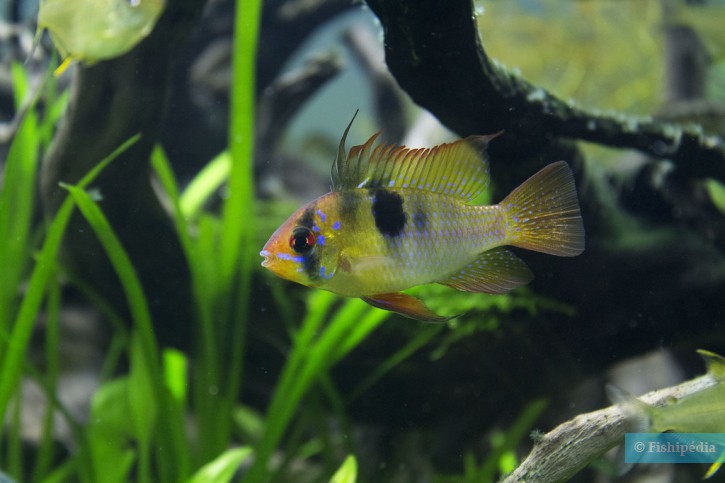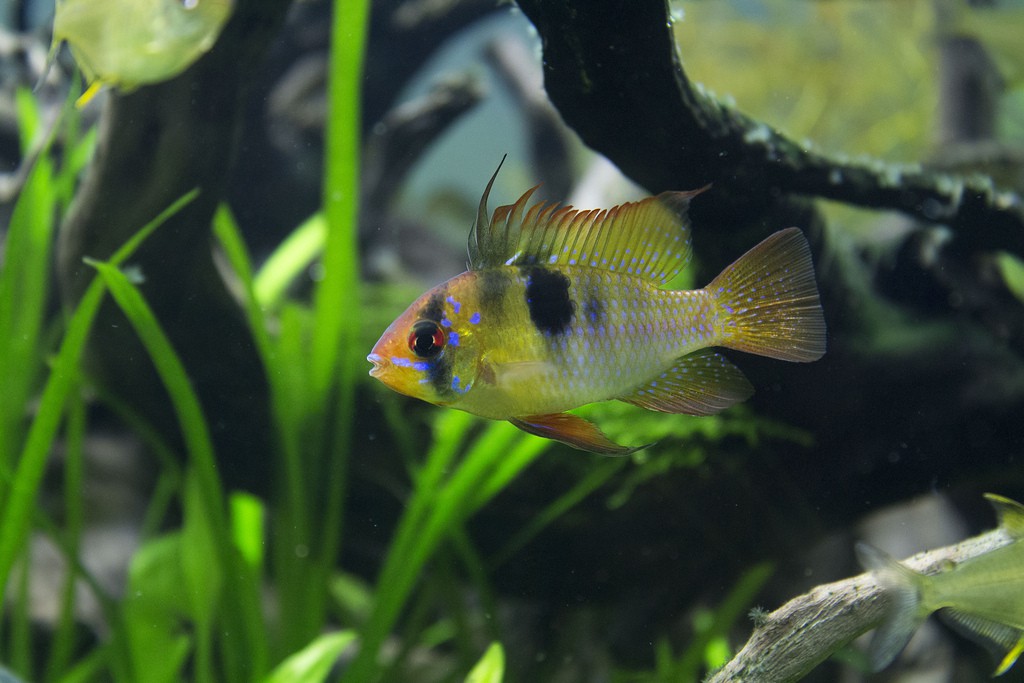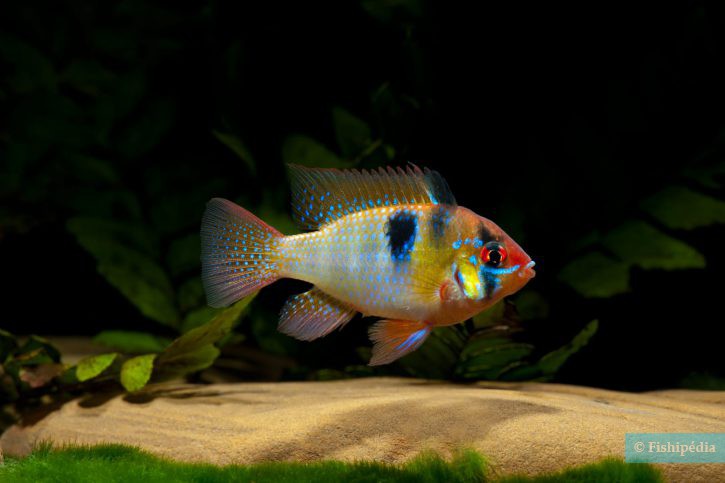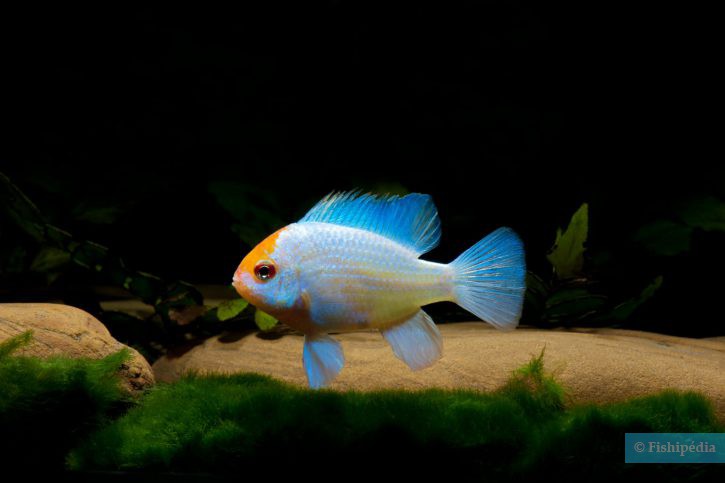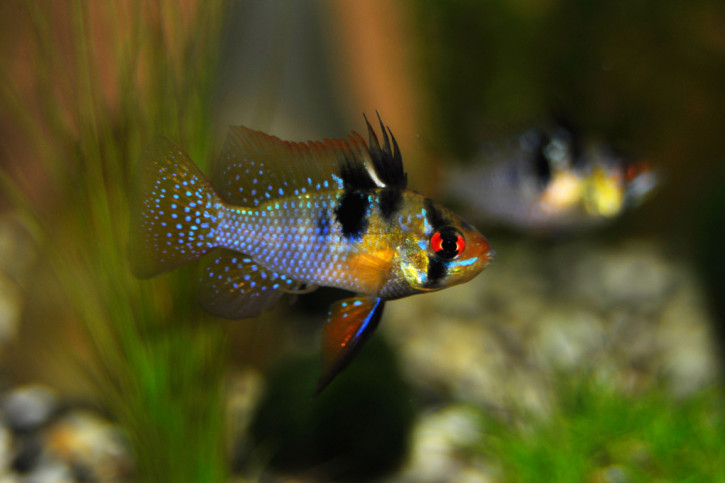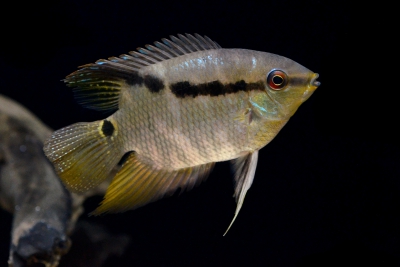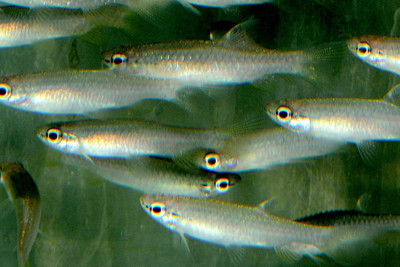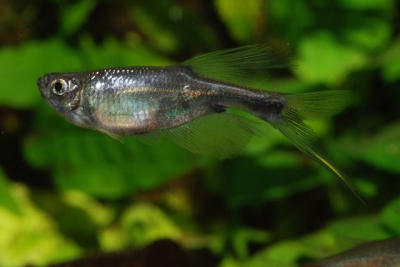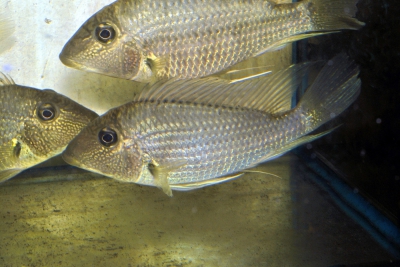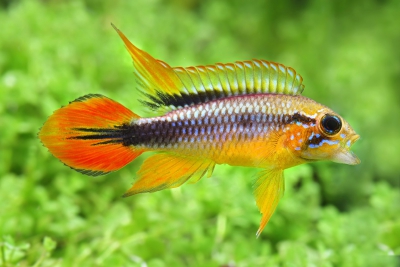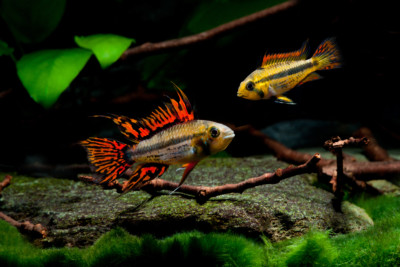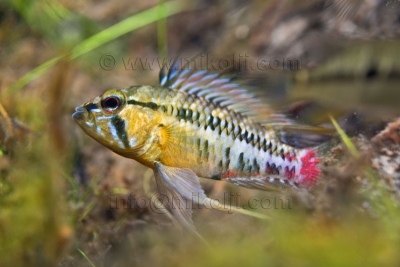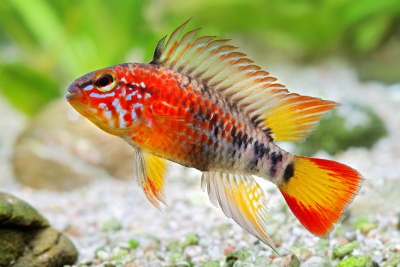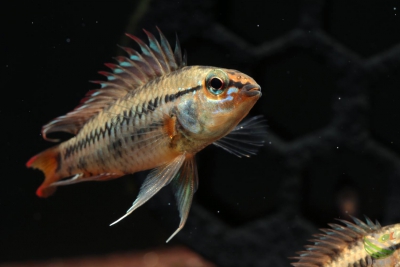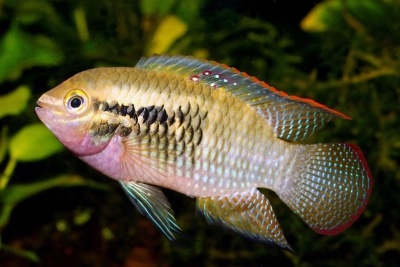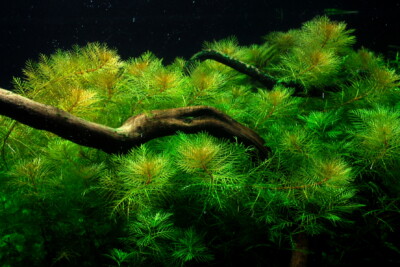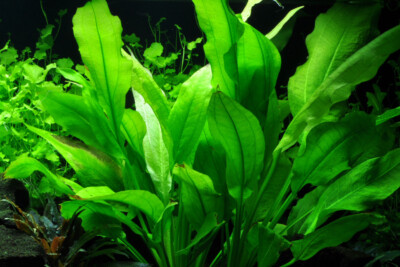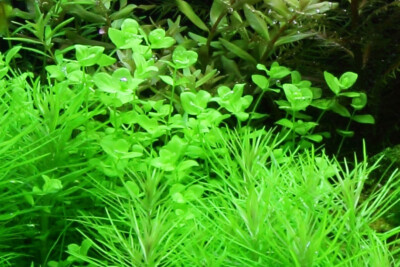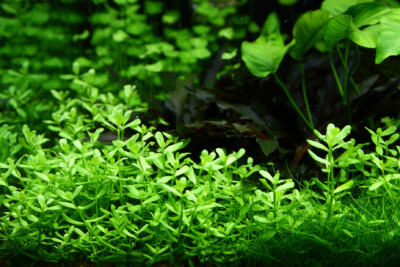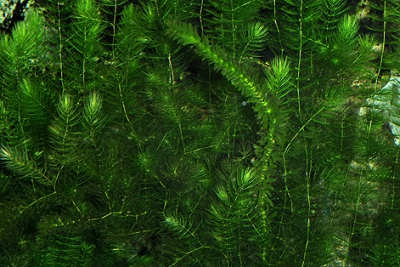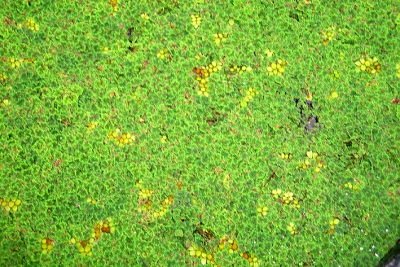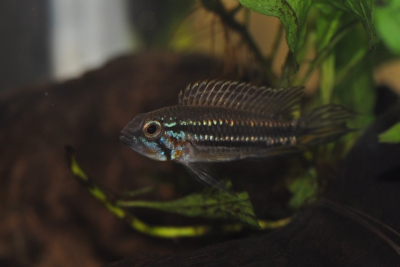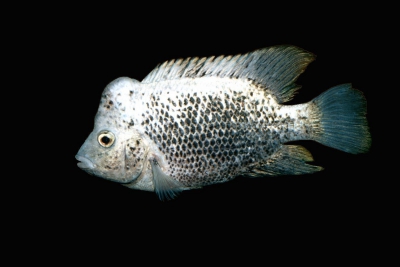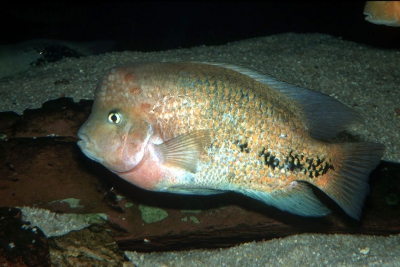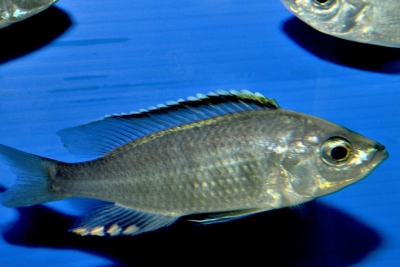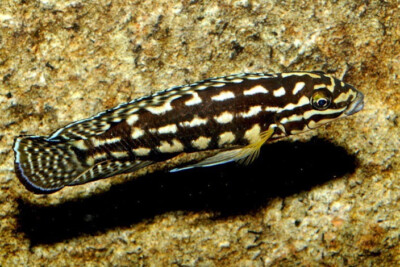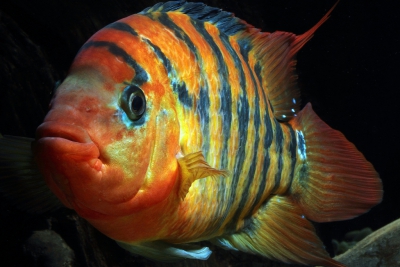Introduction
Mikrogeophagus ramirezi, commonly known as ramirezi, is a little fresh water fish from the Amérique du Sud.
This sheet is currently being prepared. The texts currently proposed come from our data model or are being drafted. To request priority for this content, you can write to us HERE.
Who is it?
Genus Mikrogeophagus
Morphology
-
Type
-
Average size3 cm
-
Maximum size4 cm
-
Longevity4 year
-
Type
-
Average size3 cm
-
Maximum size4 cm
-
Longevity4 year
How to recognize This fish ?
The ramirezi measures between 3 and 4 cm. Given its small size, this species is commonly referred to as a "dwarf" animal. This fish is multicolore with a predominantly bleu, orange and noir body.
Behaviour & Life cycle
-
dietomnivorous with carnivorous tendency
-
Sociabilityliving as a couple or in a group
-
territorialYes
-
Way of livingdiurnal
The ramirezi is a fish living as a couple or in a group naturally found near the bottom. This species is omnivorous with carnivorous tendency . Measuring only a few centimeters, this small species tends to be discreet and hide in the presence of larger neighbors.
Although slightly territorial, the ramirezi is a rather peaceful animal that generally behaves in a peaceful manner with other species. It should be noted that it is sometimes less tolerant with its conspecifics. Parades or even small jousts may occur between different members of the group until a hierarchy is established.
Reproduction
-
Reproductionovipare qui pond sur substrat découvert
The ramirezi is a fish ovipare qui pond sur substrat découvert.
Harmless species
This species does not represent any particular threats to humans when encountered in its natural environment.
Origin and distribution
What is its habitat?
Natural environment characteristics
-
Temperature23 - 30 °C
-
pH (acidity)4.5 - 6.5
-
gh (hardness)1 - 6
Biotope presentation
The acidification of water comes from the decomposition of plants. This phenomenon changes the color of the water, which tends to turn brown. In some areas particularly rich in organic matter, the water is so dark that it is called "black water".
This animal evolves in areas characterized by a strong presence of vegetation (aquatic and marsh plants, decaying organic matter, roots...).
Species of the same biotope
Main recommendations for fishkeeping
Deontology
In order to preserve wildlife, if you acquire this animal, it must not be released into the wild. See also, the Fishipedia charter.
Fishipedia supports the practice of responsible and environmentally friendly aquarium keeping. We encourage maintenance if it is motivated by a desire to understand the biological functioning of living things and if it is done with respect for animal life.
We believe that aquaristics is an opening to the discovery of aquatic environments, especially freshwater, and that this knowledge is necessary to better protect and respect these environments. Logically, we refute the compulsive purchase of animals that would not find a sufficient and / or adapted place in the host aquarium.
Our recommendations
-
Min volume80 liters
-
Population min2
-
Temperature23 - 30 °C
-
pH (acidity)6 - 6.8
Characteristics
-
Difficulty breedinghard
-
Robustnesssensible
-
Behaviourpeaceful
-
Availabilitystandard
Recommended equipment from our partners
-
Aquarium
-
Filtration
General reminders
It is strongly advised to read the complete dedicated file and to get information on the feedbacks of maintenance of the envisaged animal, this to avoid any potential conflict whose end result is generally the death of the individual (or the other inhabitants). It is important not to overload your aquarium to limit pollution. This will make maintenance easier.
In nature, animals are subject to weather conditions and live in waters with variable characteristics. The recommendations offered by our team for aquarium maintenance are a guidance and cannot be assimilated to scientific datas.
General reminder on maintenance datas
Le démarrage d'un aquarium est une partie primordiale pour l'équilibre et le bien-être des poissons. Lorsque l'on met en eau un aquarium, l'eau passe naturellement par un cycle biologique : le cycle de l'azote. Celui-ci dure environ trois semaines. Tous les 2 jours, nous vous conseillons de tester votre eau jusqu'à ce que le taux de nitrite soit à zéro pendant plusieurs jours d'affilée.
Pour accélérer ce cycle, vous pouvez utiliser un activateur de bactéries comme JBL Denitrol. Cette solution riche en bactéries vivantes et enzymes permet une mise en place rapide du cycle de l'azote. Les poissons peuvent alors être introduits plus rapidement.
Il est important de tester l'eau de son aquarium régulièrement pour maintenir un environnement sain pour les poissons et les autres habitants. Les tests d'eau permettent de mesurer les niveaux de différents paramètres tels que le pH, la dureté totale, ainsi que les taux de nitrates, de nitrites et d'ammoniaque.
Pour réaliser ces tests, vous pouvez utiliser des produits d'analyse spécialisés tels que JBL ProScan qui permet de réaliser un diagnostic de l'eau directement via un smartphone. Il existe également des coffrets de tests plus classiques de bandelettes, comme JBL PROAQUATEST.
En cas d’usage de l’eau du robinet, vous pouvez utiliser un conditionneur d’eau de type Biotopol de JBL pour éliminer les substances nocives comme le chlore, le cuivre, le plomb et le zinc. Une eau trop dure ou trop calcaire peut être inadaptée à de nombreuses espèces tropicales d’eau douce. Si nécessaire, vous pouvez la couper avec de l’eau osmosée ou de pluie filtrée afin d’obtenir une dureté plus adaptée aux besoins de vos poissons et de vos plantes. Les conditionneurs d'eau garantissent une meilleure santé aux poissons et une meilleure croissance des plantes.
Chlorine and chloramine are dangerous for the health of animals. Used to disinfect water, these agents are present in significant quantities in tap water. We recommend using an anti-chlorine agent every time you change the water. In addition to chlorine, treatments and medicines sold for aquarium use sometimes contain dangerous heavy metals in high doses.
Specific needs for the ramirezi
The ramirezi is a species which lives naturally at a temperature between 23 °C and 30 °C. The ramirezi is sensitive to abrupt changes in parameters as well as to chemicals. Its acclimation in an aquarium must be done with special care to prevent it from developing diseases or weaknesses. Nitrate levels should remain below 25mg/L. To keep the water clean and unpolluted, plan on changing 20% to 30% of the water volume each month.
The ramirezi is a species whose maintenance is rather reserved for informed aquarists . It can only be successfully carried out by carrying out a minimum of documentation work. Special husbandry conditions can easily lead to the death of the species.
This species is particularly common in the aquarium trade. Animals from long-term breeding are usually acclimatized at a temperature of about 26 °C in neutral water.
Cohabitation & Environment
In a community aquarium context, this species should be kept in a minimum volume of 80 liters.
Fearful by nature, it is advised not to let the ramirezi cohabit with large territorial species or with too aggressive fish. It can easily evolve with territorial neighbors with a peaceful temperament or with non-territorial species.
Be careful to plan an adequate space for each territorial species. Each species should have a surface and a decor allowing it to juxtapose its territory with that of its neighbors.
The ramirezi is a fish that generally lives in groups outside of the reproduction periods. If you want to reproduce them and have a good chance of forming a couple, it is recommended to keep at least 5 individuals.. In a community aquarium, the chances of survival of the larvae are almost null. After a few spawns, it is preferable to isolate the couple or to separate from the other members of the group.
The hierarchical organization and the aggressiveness between fellow fish can weaken certain individuals, the presence of hiding places becomes then necessary. If you wish to add new members, it is better to introduce younger fish. They will have a better chance of integrating into the new balance.
It should be noticed that this species should not be kept with large crustaceans or fish, as it would become a prey of choice. Smaller species should preferably be inserted in the aquarium some time before the larger ones. Moreover, if you want to breed it, it is better to put them in a specific aquarium.The species enjoys a particularly vegetation-rich environment. The addition of plants will provide many useful hiding places for resting. These areas are also conducive to possible breeding in the aquarium. Floating plants such as Salvinia can be added to recreate the subdued atmosphere characteristic of its living conditions in the wild.
Acid Water Maintenance
The ramirezi living naturally in acidic water, generally in "black" or "sieved" water, the implementation of a filtration on peat is ideal for its balance. Adding decaying leaves and alder fruit can significantly improve living conditions by naturally increasing acidity of some water.Tips for feeding
The ramirezi is omnivorous with carnivorous tendency.
This species can eat dry food (flakes, pellets), fresh food and frozen food. To avoid deficiencies, it is recommended to vary the types of food.
Feed animals in moderation to maintain good water quality. Meals should be eaten within 2–3 minutes, served in several small portions rather than a single large ration.
Uneaten food quickly decomposes, releasing ammonia, nitrites, and nitrates, which disturb the aquarium’s biological balance.
Make sure each species can access food properly, slower or bottom-dwelling individuals may require targeted feeding.Food recommendations from our partner JBL - Products PRONOVO
-
Granules
-
Flakes
-
Sticks
Reproduction protocol
-
egg-laying protectionYes
Hybridization risks
In general, it is advised not to mix several species of the same genus or different varieties of the same species, to avoid the risks of hybridization.
These animals might interest you
These plants might interest you
Plants play a crucial role in aquariums, both for their ability to filter water by absorbing excess nutrients and for their aesthetic contribution. They provide fish with natural hiding places, can serve as breeding sites, and generally help maintain the overall balance and optimal conditions of the aquarium. The selection presented here includes species from the same regions as the species described on this page, although they do not necessarily come from its exact natural biotope.
To go further
Sources & Contributions
Participation & Validation
The Fishipedia team and specialist contributors are committed to providing high-quality content. However, although the information comes from scientific sources or testimonials from specialists, the cards may contain inaccuracies.

Benoit Chartrer
Translation
Translation done with the valuable contribution of our translators, who make this information available to a wider audience. We sincerely thank them for their commitment.
Bibliographic references
- - GBIF
- - Check List of the Freshwater Fishes of South and Central America - Carl J. Ferraris, Jr. - Roberto E. Reis - Sven O. Kullander - EDIPUCRS - 2003.
- - Male mate choice for a female ornament in a monogamous cichlid fish, Mikrogeophagus ramirezi - Lori H. LaPlante - Samantha Delaney - journal of fish biology - 2020.
- - Nomenclatural availability of putative scientific generic names applied to the South American cichlid fish Apistogramma ramirezi Myers & Harry, 1948 (Teleostei: Cichlidae) - Sven O. Kullander - ZOOTAXA - 2011.
Scientific partners
Species of the same family
Species of the same biotope
